On the cusp of the decade of film decadence, Texas-born Tobe Hooper wrote and directed the now-iconic horror masterpiece "The Texas Chain Saw Massacre" in 1974 and cemented his standing as one of the leading figures in modern American horror movies.
It follows a group of five free-spirited teenagers on a trek through central Texas that progresses into a gut-wrenching illustration of society at its most despicable. "Texas Chain Saw" has long been revered as a peak of abhorrent cinema that synthesizes a horrific set of events ultimately grounded in reality that’s lost in today's banal blockbuster horrors.
"Texas Chain Saw" is a gritty depiction of mankind's depravity while serving both as an objectively commercial success and a testament to how horror movies should look and feel.
While the movie's central plot is not a direct imitation of life, Hooper pulled from the seemingly incessant San Antonio radio news coverage of various violent crimes and infamous murderers, such as Ed Gein and Elmer Wayne Henley, to paint his portrait of horror through realism.
The film opens with a written preface: "The events of that day were to lead to the discovery of one of the most bizarre crimes in the annals of American history," leading some first-time viewers into believing the morbid tale is based on a true story. The opening was a marketing ploy, as Hooper aims to employ and maintain a fraught realism throughout his film.
This written ruse to blur the lines of reality and fiction, coupled with Hooper's first macabre zoom shot of a rotting corpse relishing in its own newscast recited by a Walter Cronkite-esque offscreen voice, is Hooper's way of establishing the stark reality of the ensuing events.
The most terrifying aspect of "Texas Chain Saw" is the gnawing realization that everything depicted is possible. Our group of indifferent youths are brutalized by the campy Leatherface but not plagued by a desocialized, bestial family with an insatiable lust for death and torture.
Depictions of moral decline are plentiful in post-Vietnam horror movies, from 1974's "Black Christmas" to 1978's "Halloween," killers delved deeper into anonymity, offering a bleak and impersonal depiction of America's savage underbelly where gratuitous violence takes center.
"Texas Chain Saw" fits this type of postmodern, morally bankrupt horror movie almost perfectly with a disguised killer donning a lipstick-stained, human-leather mask and acting out their sadistic desires on innocent, socially liberated travelers.
The fact that all of the early deaths occur in broad daylight and are a result of the victims' mere curiosity pushes this sense of realism further and subverts the notion that, in the horror genre, daylight is viewed as a state of safety. The notion that darkness breeds violence and masked killers must be lurking in the shadows to effectively prey on bystanders no longer exists.
The obscene amount of human remains in Leatherface's house, the repugnant image of a flailing body hanging from a meat hook and the kitschiness of a gaudy chainsaw being used as the killer's weapon all add a layer of grisly drama. But Hooper never decides to divert from the plot's grounding in reality by introducing a paranormal subplot.
Hooper's original movie also spurred a financially sound franchise of movies, comic books and even a video game of the original film, which all speak to how impactful Hooper's depiction of abject reality has been over the course of nearly 40 years.
Horror fans thrive off a movie's ability to instill fear in the viewer, and a story that is based on and grounded in real life, even with fabricated specifics, adds nuance to that fear.
As a classic horror movie that played a substantial role in reimagining the genre, "Texas Chain Saw" will likely remain a fan favorite for the foreseeable future — and for good reason. The horror of realism resonates with viewers better than a supernatural story ever could, which is precisely why “Texas Chain Saw” became and will always be a pinnacle of the genre.
Reach the reporter at stellefs@asu.edu and follow @samtellefson on Twitter.
Like The State Press on Facebook and follow @statepress on Twitter.
Sam Ellefson is the Editor of State Press Magazine, leading a team of writers, editors and designers in creating four print issues each semester. Sam is a senior getting dual degrees in journalism and film studies and is pursuing an accelerated master's in mass communication at ASU.




